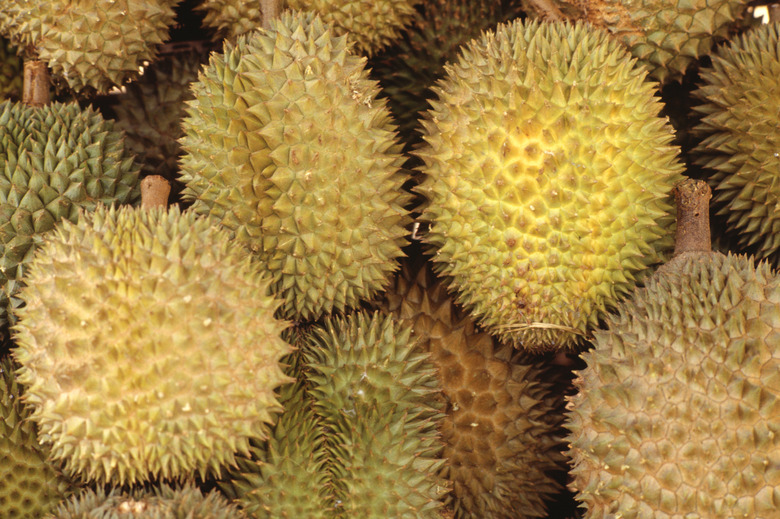Durian Tree Adaptations
Native to Southeast Asia, the durian tree has not been grown successfully in many other places. Most well-known for its pungent, strange-tasting fruit, this is actually one of the many adaptations that has made the tree so successful in the areas where it has been found to thrive.
Flowers and Pollination
Durian flowers sprout directly from the main trunk of the tree, and form in large clusters. Colors range from off-white to brown, and they have a smell that is nearly as distinctive as the fruits that develop from them. The flowers are closed during the day and open at night, as the main pollinator of the durian is the dawn bat. Attracted by the smell and the nightly appearance of fresh pollen, the dawn bat visits numerous flowers in turn and spreads the pollen. Although both male and female flowers will be born on the same tree, these flowers open at different times, making more than one tree necessary.
- Native to Southeast Asia, the durian tree has not been grown successfully in many other places.
- The flowers are closed during the day and open at night, as the main pollinator of the durian is the dawn bat.
Fruits
The fruits appear once a year, and have a strong smell that has been attempted to be described numerous times — with often completely different results. The smell might make humans nauseous, but it attracts monkeys, birds and rodents. The fruits fall from the tree and often smash open on the ground, where they are consumed — or broken apart and eaten — by the animals attracted to the scent. The fruits contain only five seeds, which can pass undigested through the animal and are deposited elsewhere when the animal eliminates. The seeds are large, and generally are only eaten by the large animals that the fruit attracts, such as the elephant.
Bark
The bark of the durian tree is rough and textured with a number of cracks and breaks running vertically along the tree's surface. The bark periodically peels off in irregular patterns as a defense mechanism against some of the harmful plant growths that can appear on the bark of the tree. The areas where durian fruits are native are also home to a variety of epiphytes and vines that are known to attach themselves to trees to climb to the canopy; in the process, they can slowly strangle the trees they are attached to. The peeling bark eliminates the threat of this, and, with it, any parasitic plants are also sloughed off.
- The fruits appear once a year, and have a strong smell that has been attempted to be described numerous times — with often completely different results.
- The fruits fall from the tree and often smash open on the ground, where they are consumed — or broken apart and eaten — by the animals attracted to the scent.
Buttresses
The durian tree can grow to mature heights of up to 150 feet tall; this height helps to ensure that at least some of the fruits will smash when they hit the ground, attracting animals. The tree can form buttresses to help steady it against the elements and help to keep it straight. Without these buttress roots, the trees would be extremely susceptible to being blown down in windstorms or damaged in other types of weather.
